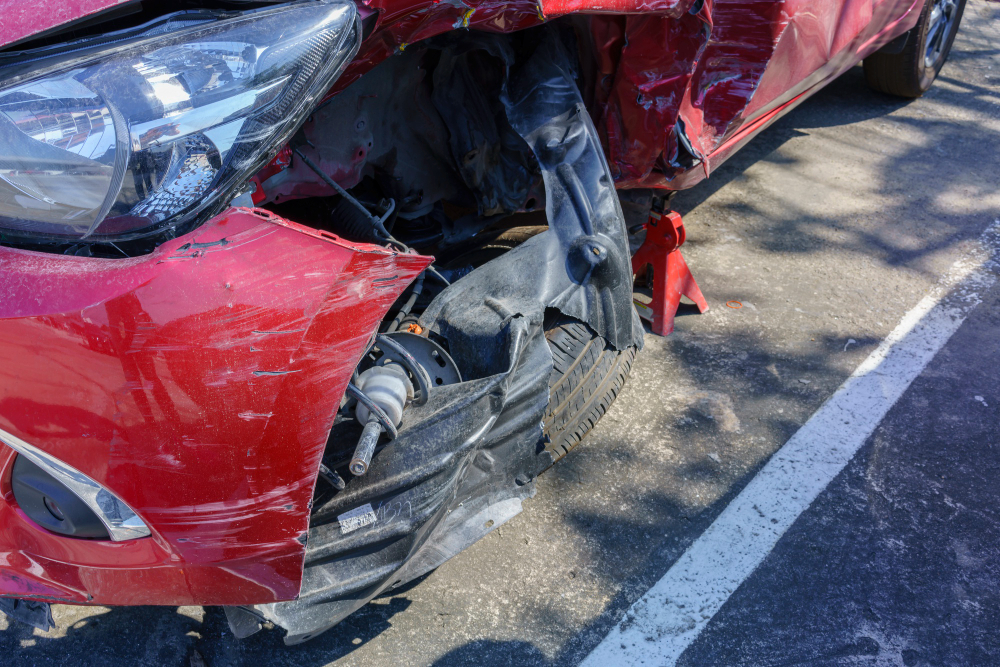When it comes to car accidents, insurance companies play a crucial role in determining the fate of your vehicle. In many cases, insurance companies will declare a car a total loss if the cost of repairs exceeds a certain percentage of the car’s value. But what exactly is that threshold, and when do insurance companies decide it’s time to declare a car a total loss?
In this article, we will delve into the factors that insurance companies consider when determining if a car is a total loss. From the extent of the damage to the market value of the car, we will explore the key indicators that influence this decision. Additionally, we will discuss what happens once a car is declared a total loss, including the process of filing a claim and receiving a payout.
Understanding when insurance companies declare a car a total loss is essential for anyone involved in an accident. By having this knowledge, you can better navigate the claims process and make informed decisions about your vehicle’s future. So, let’s dive in and uncover the ins and outs of this important insurance matter.
What does it mean for a car to be declared a total loss?
When an insurance company declares a car a total loss, it essentially means that the vehicle has sustained damage that is so severe that it is not economically feasible to repair it. This determination is critical because it affects not only the vehicle’s status but also the insurance claim process and potential payouts. A total loss declaration signifies that the cost of restoring the vehicle to a safe and operational condition would exceed its market value before the accident occurred.
The total loss designation can arise from various circumstances, including collisions, natural disasters, or any incident that causes significant structural damage. For many drivers, this can be a frustrating experience, as it often leads to the loss of a vehicle they relied on for daily transportation. Understanding this designation is essential for navigating the aftermath of an accident, including how to handle insurance claims and what steps to take next.
Furthermore, the total loss classification can impact the vehicle’s title status, affecting future ownership and resale opportunities. Once a vehicle is declared a total loss, it typically receives a salvage title, which indicates to potential buyers that the car has been significantly damaged in the past. This distinction can lower the vehicle’s value and complicate its sale, making it crucial for vehicle owners to comprehend the implications of a total loss declaration.
The factors insurance companies consider when determining if a car is a total loss
Insurance companies evaluate several crucial factors when deciding whether to declare a car a total loss. One of the primary considerations is the extent of the damage sustained by the vehicle. This includes both visible damage, such as dents and broken components, and hidden damage that may not be immediately apparent. The assessment often involves a thorough inspection by a claims adjuster or a qualified mechanic to determine the full scope of the necessary repairs.
Another significant factor is the vehicle’s pre-accident market value, which is determined through various methods, such as comparing similar vehicles in the local market or using valuation tools. The insurance company will typically refer to databases that track car values based on make, model, year, mileage, and condition. If the estimated cost of repairs approaches or exceeds a certain percentage of this market value—often around 70-75%—the car may be deemed a total loss.
Additionally, the age and condition of the vehicle prior to the accident can influence the decision. For example, a newer car with relatively low mileage may be repaired rather than declared a total loss, even if the damage is substantial. In contrast, an older vehicle that has already depreciated significantly may be more likely to be written off. Insurers also consider any previous claims on the vehicle, as a history of damage can affect its overall value and the likelihood of repair being deemed worthwhile.
The formula insurance companies use to calculate the total loss threshold
Insurance companies commonly use a specific formula to determine whether a car qualifies as a total loss. While the exact percentages and calculations can vary between insurers, the fundamental principle remains the same: they compare the cost of repairs to the vehicle’s actual cash value (ACV). The total loss threshold is typically set around 70-75% of the ACV, although some companies may use a slightly different figure.
To calculate the threshold, insurers first assess the vehicle’s pre-accident market value. This value is often determined using industry-standard valuation guides, which take into account factors such as age, mileage, condition, and market demand. Once the ACV is established, the insurance company will estimate the repair costs associated with the accident. This estimate includes parts, labor, and any additional expenses required to restore the vehicle to its pre-accident condition.
If the estimated repair costs exceed the predetermined threshold percentage of the ACV, the vehicle is then classified as a total loss. This formula serves to protect insurance companies from incurring excessive repair costs that would not be justified by the vehicle’s value. Understanding this formula can help vehicle owners grasp the rationale behind the insurance company’s decision-making process and prepare for the subsequent steps in the claims journey.
Common scenarios where insurance companies declare a car a total loss
There are several common scenarios in which insurance companies are likely to declare a car a total loss. One prevalent situation occurs after serious accidents, particularly those involving high-impact collisions. In such cases, the damage may be extensive enough that repairing the vehicle is not cost-effective. This typically applies to accidents that involve significant structural damage, such as frame issues or major engine damage.
Another scenario involves natural disasters, such as floods or hurricanes. Vehicles that have been submerged in water can suffer extensive damage, including electrical system failure and mold growth. In many cases, the cost to restore a flood-damaged vehicle exceeds its market value, leading insurers to classify it as a total loss. This designation also serves to protect consumers from purchasing vehicles that may have hidden damage stemming from such events.
Additionally, vehicles that are stolen and later recovered may also be declared a total loss if they have been damaged beyond repair during the theft or if the cost of recovery and repair surpasses their value. In these instances, the insurance company must weigh the cost of restoration against the car’s worth to determine the appropriate course of action. Each of these scenarios illustrates how various factors can converge to result in a total loss declaration, highlighting the complexities of the insurance process.
Steps you can take if your car is declared a total loss
If your car is declared a total loss, it can feel overwhelming, but there are steps you can take to effectively manage the situation. First and foremost, review the insurance company’s assessment carefully. Ensure that you understand how they arrived at their decision, including the calculations related to the vehicle’s actual cash value and the estimated repair costs. If you believe that the valuation is inaccurate, gather evidence to support your claim, such as receipts for recent repairs or documentation of the vehicle’s condition before the accident.
Next, familiarize yourself with your insurance policy and the coverage it provides for total loss situations. Most policies will outline the process for handling total loss claims, including the timeline for receiving a settlement offer. Keep in mind that you may have the right to negotiate the settlement amount, especially if you have evidence that supports a higher value for your vehicle. Being informed about your rights and options is crucial in ensuring you receive a fair payout.
Finally, consider your options for moving forward after the total loss declaration. This may include purchasing a new vehicle, exploring financing options, or considering alternatives such as leasing. If you choose to buy another car, keep in mind that the total loss settlement can serve as a down payment. Additionally, if your previous car was financed, you will need to communicate with your lender regarding the total loss status and any outstanding balance on the loan. Taking these proactive steps can help you navigate the transition and move forward with confidence.
Understanding the salvage title and salvage value of a totaled car
Once a car is declared a total loss, it often receives a salvage title, which is a legal designation that indicates the vehicle has been significantly damaged and is not roadworthy without extensive repairs. A salvage title serves as a warning to potential buyers that the car has a history of major damage. This designation can impact the resale value of the vehicle and may affect the owner’s ability to obtain insurance for the car in the future.
The salvage value of a totaled car is the amount the insurance company will pay you for the vehicle, taking into account its pre-accident value minus any applicable deductions for the damage. This amount is typically lower than the actual cash value since it reflects the vehicle’s status as a salvage. The insurance company may also sell the car to a salvage yard or auction it off, which can further influence the payout offered to the owner.
Understanding the implications of a salvage title and salvage value is essential for vehicle owners facing a total loss scenario. This knowledge can help you make informed decisions about whether to accept the insurance company’s offer or pursue further negotiations. Additionally, being aware of how salvage titles work can prepare you for any future transactions involving the vehicle, whether you’re considering repairs or trying to sell it down the line.
Dealing with the insurance company’s settlement offer for a totaled car
Receiving a settlement offer from your insurance company for a totaled car can be both a relief and a source of stress. The offer represents the insurance company’s assessment of your vehicle’s value, but it may not always align with your expectations. It’s essential to approach this stage with a clear understanding of your vehicle’s worth and the factors that have influenced the offer.
Start by carefully reviewing the settlement offer, including the breakdown of the calculation used to determine the payout amount. Take note of the vehicle’s actual cash value, the estimated repair costs, and any deductions that may have been applied. If you believe the offer is too low, gather supporting documentation, such as comparisons to similar vehicles on the market, repair estimates, and any recent appraisals. This evidence can strengthen your position when negotiating with the insurance company.
When you are ready to respond to the settlement offer, communicate your concerns clearly and professionally. Present the documentation you’ve gathered and explain why you believe a higher payout is warranted. Be prepared for potential pushback from the insurance adjuster, as they may have their own set of data to support their offer. Remain patient and persistent, as negotiating can be a lengthy process, but advocating for a fair settlement can yield positive results.
How to negotiate with the insurance company for a fair total loss settlement
Negotiating a fair total loss settlement with your insurance company requires preparation, confidence, and effective communication. The first step is to gather all relevant documentation that substantiates your claim for a higher payout. This can include comparative market analyses, repair estimates, and any recent maintenance records that demonstrate the true value of your vehicle prior to the accident. The more evidence you have to support your case, the stronger your position will be during negotiations.
Next, approach the negotiation process with a clear understanding of your vehicle’s worth and the specific reasons why the initial offer is insufficient. When communicating with the insurance adjuster, be clear and concise about your expectations and the rationale behind them. Maintain a professional demeanor throughout the process, as being respectful can foster a more productive dialogue. Consider asking for a meeting or phone call instead of relying solely on email correspondence, as direct communication can often yield better results.
Finally, be prepared to be flexible during negotiations. While it’s important to advocate for a fair settlement, understanding the insurance company’s perspective can help you find common ground. If the adjuster is unwilling to meet your desired payout, consider proposing a compromise or asking for additional benefits, such as coverage for rental car expenses while you search for a replacement vehicle. By being open to various solutions, you can increase the likelihood of reaching a satisfactory outcome.
Tips for avoiding a total loss situation with your car insurance
While some accidents are unavoidable, there are proactive measures you can take to minimize the risk of your vehicle being declared a total loss. First and foremost, maintain your car regularly and address any mechanical issues promptly. A well-maintained vehicle is less likely to suffer catastrophic failures that could lead to severe accidents. Additionally, ensuring that your tires, brakes, and other critical systems are in good condition can help you avoid accidents altogether.
Another strategy is to consider comprehensive insurance coverage that protects against a wider range of incidents, including theft, vandalism, and natural disasters. This type of coverage can provide peace of mind and financial protection in cases where damage occurs outside of typical collision scenarios. Review your policy periodically to ensure you have adequate coverage for your needs, and consider increasing your deductible if you’re comfortable with that option, as it can reduce your premium costs.
Lastly, practice defensive driving techniques to reduce the likelihood of accidents. Stay alert, follow traffic laws, and avoid distractions while driving. By being proactive about safety, you not only protect yourself but also minimize the chances of your vehicle being involved in an accident that could result in a total loss declaration. Implementing these strategies can save you time, money, and stress in the event of an unforeseen incident.
Conclusion: Understanding the process of declaring a car a total loss can help you navigate the insurance claims process and ensure you receive a fair settlement.
Navigating the complexities of the insurance claims process after a car has been declared a total loss can be challenging, but understanding the factors involved can empower you as a vehicle owner. By grasping the meaning of a total loss declaration, the criteria used by insurance companies, and the steps you can take to manage the situation, you can approach the claims process with confidence.
Engaging in the negotiation process and advocating for a fair settlement is essential. Armed with knowledge and documentation, you can effectively communicate your value expectations to the insurance company and work towards a resolution that reflects your vehicle’s worth. Additionally, taking preventive measures to avoid a total loss situation not only preserves the value of your vehicle but also enhances your overall driving experience.
Ultimately, while the loss of a vehicle can be disheartening, understanding the implications and processes involved can help you navigate this challenging situation. By remaining informed and proactive, you can protect your interests and ensure that you receive the compensation you deserve.





























